Myanmar (Burma), Four Days In
We wrote about Myanmar (Burma) as we traveled around the country, but since Internet connections were either horrendously slow or nonexistent, we were unable to get anything online until after we had left the country. So while we will be uploading these posts over the next few weeks, everything we discuss in them was actually going on at the time they were written. This particular post, describing our first few days in the country, is kind of a long one because we were struck so quickly by so much of what we saw. Everything seemed unusual and intriguing, and we found ourselves excitedly chattering about what we were experiencing in a way that we haven’t done anywhere else. It is just that kind of place.
Finally, for the sake of convenience, we’ll refer to the country as Burma from here on. In fact, what to call the country isn’t entirely clear. It was known as Burma until 1989, when the military government decided the name should be changed to Myanmar. While Myanmar does more accurately reflect that various other groups of people live in the country in addition to the Burmese, democracy advocate and Nobel Peace Prize winner Aung San Suu Kyi has said she prefers the name Burma because the people were never consulted about the name change.
Oh, and check out the homepage, where we’ve uploaded a few new banners!
* * *
One of my favorite things about welcoming a new year is checking out the New York Times’ annual “Places to Go” article, which always comes out in early January. This year, Burma was number three on the list of places to visit (beating out Oakland by two spots!), which is not surprising to us; in fact, we kind of expected it once we landed in Yangon and took a look around. This is a country shrouded in mystery and controversy, and visiting it must be akin to visiting anywhere else in Southeast Asia forty or fifty years ago. The people are genuinely hospitable and friendly, if not outright fascinated by the sight of foreigners. There is an untouched quality to everything that makes Burma different from any place we have ever been.
First off, though (with apologies to the Talking Heads), “how did we get here?” Or, better put, “why did we get here?” At the start of this adventure, Burma wasn’t even on our list. I knew only that it was a controversial nation, and that there had been a tourism boycott put in place in protest of the country’s human rights record and its house arrest of Aung San Suu Kyi.
But then, as we were traveling the world, the weirdest thing happened. It seemed that everyone we met was asking us, with a huge smile and glint in their eye, “but have you been to Burma?” Their descriptions of vast plains filled with temples as far as the eye could see, of unspoiled beaches, and of incredible food were too enticing to ignore. We started to believe, superstitiously, that something was telling us to go to Burma. After all, our meeting all of these different travelers who all said it was the most amazing place they’d ever been had to mean something! Aung San Suu Kyi’s recent release and the lifting of the tourism boycott were the icing on the cake. There was no excuse for not going.
So we went.
We could see things would be different in Burma pretty much from the get-go. The taxi that took us from the airport to our hotel, like all taxis in Yangon, was an old Toyota from the early 1980s, which belched and wheezed the whole way, and which lacked some pretty basic stuff like air conditioning, seatbelts, and a meter. Also like pretty much every car and bus in Burma, it was a right-hand drive car… but they also drive on the right. (This means that when a bus driver is trying to overtake another vehicle on a two-lane road, he can’t see anything and has to rely on his assistant to tell him when it’s safe to pass. It’s really fun.)
Another indication that we were in a place like nowhere else was the money situation. Since Burma is an entirely cash-driven society – no credit cards, no travelers’ checks, and no international ATMs – we had to get enough U.S. dollars before we left home to last the duration of our trip. Once we arrived, we then had to find a way to change about half of our dollars into Burmese kyats (pronounced “chats”). We would keep the remaining dollars for hotel bills and entry fees for museums and other attractions, which are almost always priced in U.S. currency.
The airport has an official currency exchange counter, but – at least until very, very recently – you would have to be a fool to use it. The official government exchange rate is around 6 kyats to the U.S. dollar (though this may be changing; after we arrived, we heard from other travelers that the rate had gone up substantially). If, like we did, you instead pay a visit to the men wandering the alleyways of the Bogyoke Aung San Market in downtown Yangon, you will get a “black market” exchange rate of 800 kyats to the dollar. Yep, you read that right. You just have to be sure that your dollars are in absolutely pristine condition, meaning no folds, tears, or smudges, and that they are dated no earlier than 2006. And even when your dollars are perfect, the money changers will often find a way to point to a non-existent spot on the bill and say “for this, 1000 kyats less.” At this point, you don’t have much of a choice, and 1000 kyats is just over a dollar anyway so you probably won’t argue, but it’s still an annoying trick.
The oddest part of the whole transaction is that it’s so open. We counted out our massive stacks of kyats (and the money changers counted the less-massive stacks of dollars), and then did our deal, in plain view in the middle of the market. In a country where everyone is careful with their words and actions because someone is probably always watching you, it was clear that the government must know full well that this is happening, yet doesn’t really care.
Once you have your kyats, you might still have some novel currency issues to deal with. Our first morning in Yangon, we found a coffee shop near our hotel with (miracle of miracles!) real coffee and fairly fast wi-fi. After paying for our coffee, our change arrived along with a little wet wipe. Pierre quickly realized that the change was 200 kyats short, and when he asked the waiter about it, we were sheepishly told that they were out of small bills, and that the wet wipe was a substitute for the 200 kyats!
As we wandered through Yangon (formerly known as Rangoon, which was the British name for the city) during our first couple of days in the country, we came across several remnants of British colonial rule, including a huge government building amusingly called the “Telegraph Office.” We were somewhat surprised to see how many people sold posters and t-shirts bearing the likenesses of Aung San Suu Kyi and her father, General Aung San. Even though the government won’t acknowledge it, both Aung San and his daughter are heroes to the people of Burma.
We of course tried traditional Burmese food, including a delicious maple sugar-like candy served as dessert. Vegetarianism is a strange concept here and Pierre hasn’t yet been enthused by the meat entrees, but we’ve found the veggie side dishes to be tasty, if a bit oily.
Later, as we passed through an Indian neighborhood, we paused for a delicious lassi break:
In a market, I bought fabric and had a longyi made for myself in about 5 minutes, and for all of $6 or so. The longyi is an essential Burmese item of clothing, worn by men and women alike (though the women never seem to have to fuss with theirs the way I do).
Pierre and I couldn’t help but point out all of the other fascinatingly different things we were seeing and hearing as we walked, like the rope dangling from a roof with a bell on it that was used as a doorbell for an upstairs apartment; the women’s faces all painted with thanakha, a yellow paste they use as sun protection; the kissing sound customers use to get waiters’ attention in restaurants; the pickup trucks that act as buses, overflowing with people so that some are hanging off the back and some are sitting on the roof; the ridiculously broken sidewalks that made Easter Island’s look well-maintained.
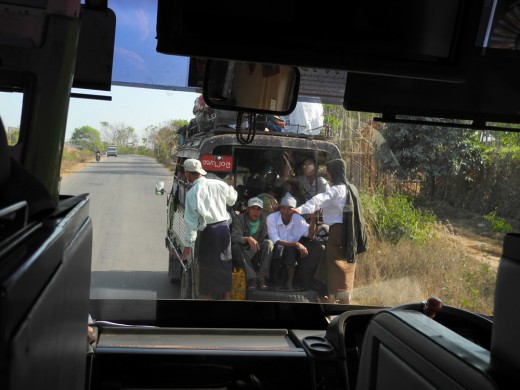
A typical Burmese pickup truck. Actually, a typical truck has a lot more people on the back, and on the roof.
As much as we were ogling the Burmese, they ogled back in spades. Foreigners are few and far between in Burma, and when we’re spotted, we are almost always greeted with a bit of staring, followed by a big smile and a friendly “Hello!” The kids are my favorite, because they look at us like they are in complete shock, but once we give them a smile or a wave, their guard goes down and they burst out giggling.
At sunset on our last night in Yangon, we made our way to the famous Shwedagon Pagoda, one of the most stunning Buddhist sights anywhere. It is an enormous gold stupa, adorned with over 5000 diamonds, including a diamond at the very top that is supposedly 76 carats. Surrounding the stupa are about a million other little shrines, Buddha statues, snack stands (of course), and some other buildings that seem like they would fit in better in Las Vegas than in Yangon.
The next morning, we caught a bus to the town of Kinpun, southeast of Yangon and base camp for journeys up Mount Kyaiktyo to the Golden Rock. As its name suggests, the Golden Rock is just that – an enormous rock covered in gold leaf and balancing precariously on the side of a cliff. It is a site of deep importance to Burmese Buddhists, and it is no easy feat to reach it. First, there is the five-hour bus ride to Kinpun. Once in Kinpun, people are shepherded into a large pickup truck with insanely uncomfortable wooden beams placed in the back and used as seats. There are about six inches of legroom between each beam, and they cram as many people as they can into each vehicle so they can make as much money as possible. Then the driver takes off at the speed of light and barrels up the side of the mountain with no concern for the safety of his passengers, flying around corners and barely avoiding oncoming vehicles.
After some 45 minutes of driving, the passengers are unloaded in a dusty parking lot, from where they will begin the hour-long uphill slog to the rock. If you would prefer not to walk (and/or want to pretend like you’re living in British colonial times), you can have four Burmese men carry you up in a chair:
On the way up the mountain (we walked, thank you very much), we passed by food stalls and souvenir stands selling toy guns made of bamboo and emblazoned with the letters “U.S.A.,” as well as bowls of miscellaneous internal organs, millipedes, goat heads, and bear claws (real ones, not pastries), labeled “medicine” by the vendors. It was beyond creepy.
At long last, we arrived at the Golden Rock. It was impressive, I guess, though we had a hard time believing there weren’t a few bolts and screws holding the rock in place.
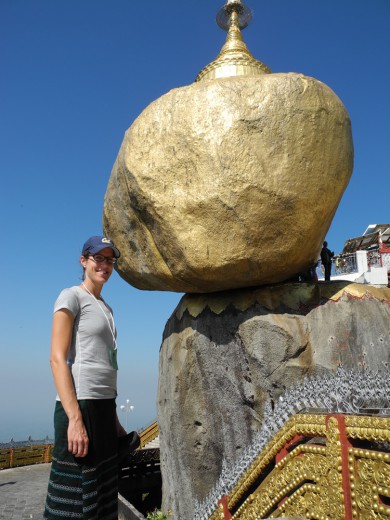
Me, my longyi, and my special "foreigner" badge around my neck. Too bad I wasn't allowed anywhere near the Rock, as women are prohibited. Grrr.
As was the case at the Shwedagon Pagoda, the Golden Rock was surrounded by kitschy souvenir and cold beverage stands, which detracted from the spiritual atmosphere more than a little. Burmese families were camped out in the area around the Rock, but we opted not to linger and made our way back down to the bus, and then (after waiting about an hour for the bus to fill up) back to Kinpun.
The next day, it was back to Yangon, where we would catch another bus to Burma’s new capital city, Nay Pyi Daw. More about the amazing fun of Burmese bus rides, and our adventures as the only tourists in all of Nay Pyi Daw, coming soon!

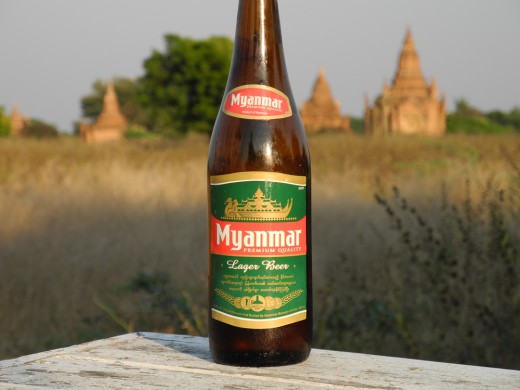
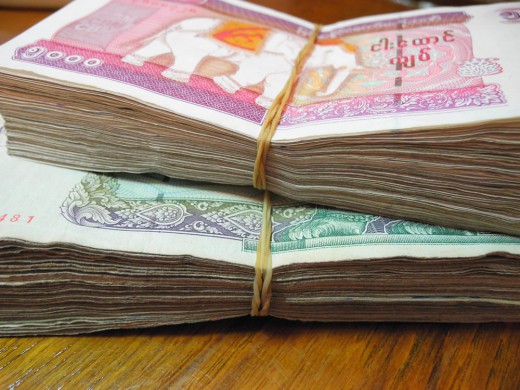
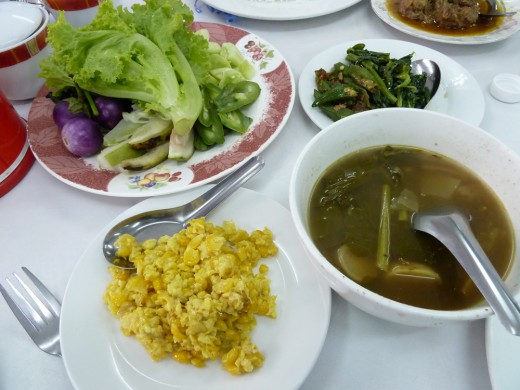
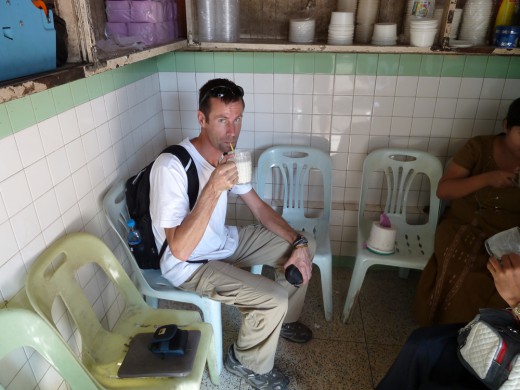
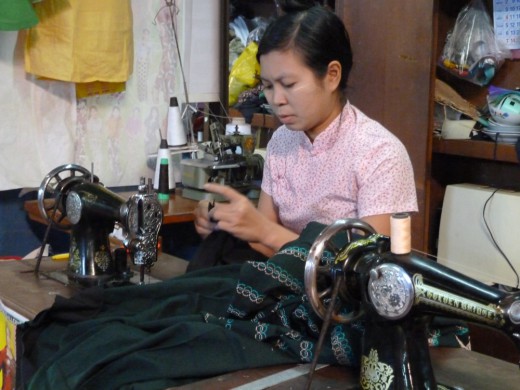
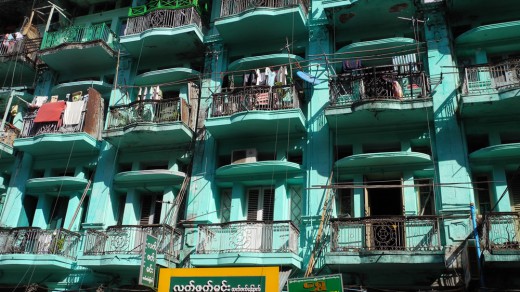
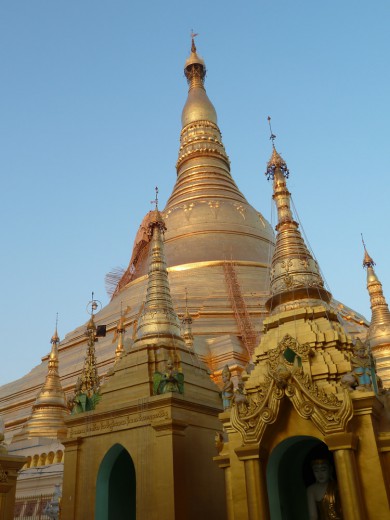
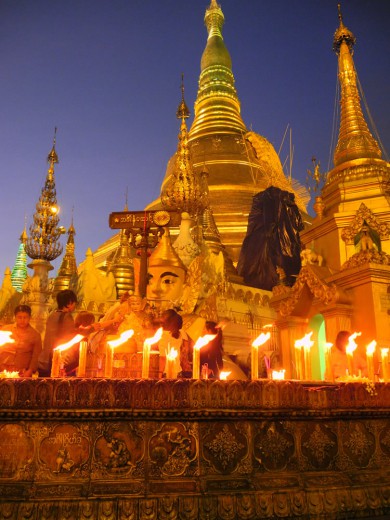
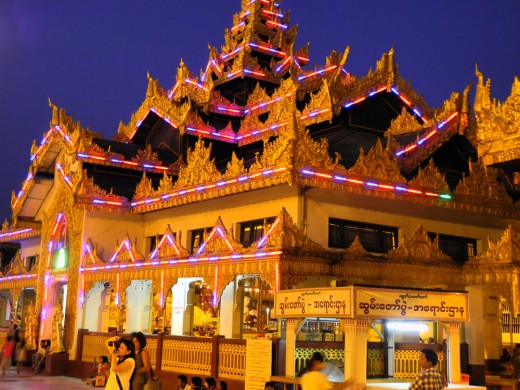
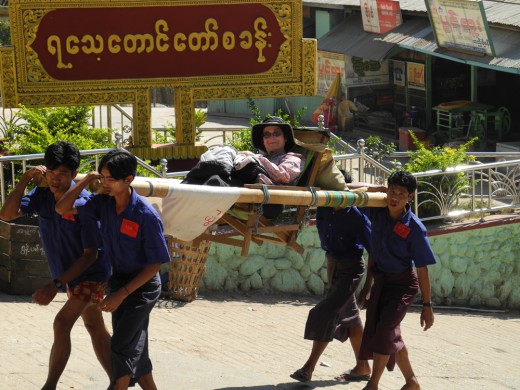
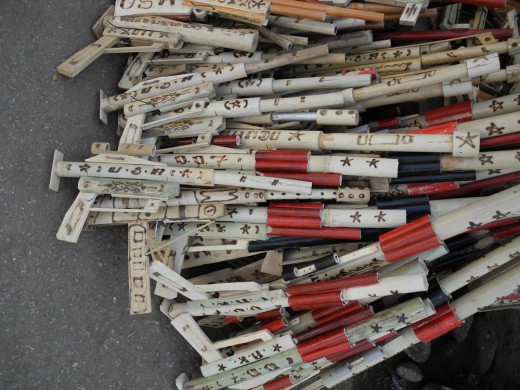
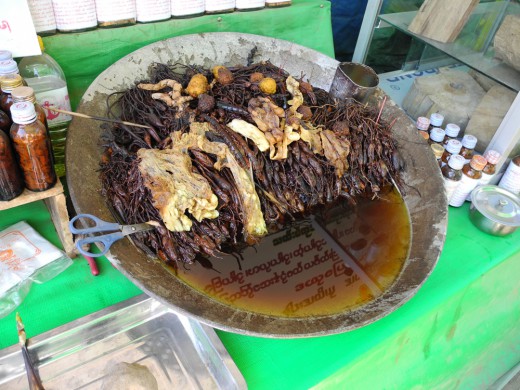
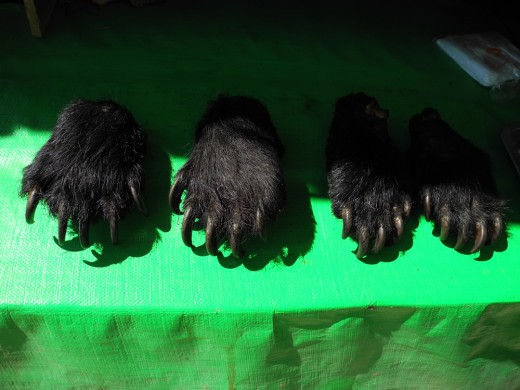
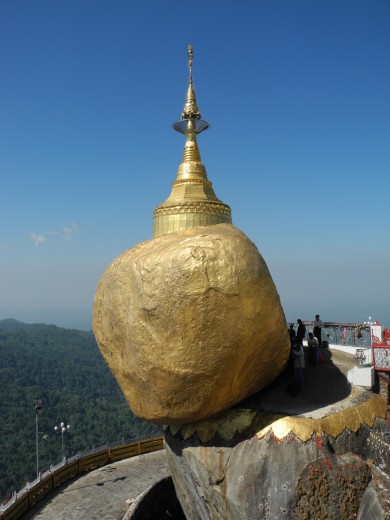
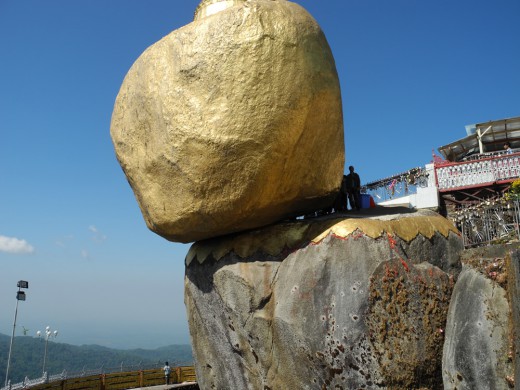
7 Comments
Ed
January 28, 2012Spectacular! Of all the places you’ve reported on, this is the one that I want to visit someday…can’t wait!
Robin
January 28, 2012Glad you enjoyed it. You should go soon! It was changing while we were there, and is bound to change a LOT more in the near future. (We’ll talk more about these changes in upcoming posts.)
Eirik
January 29, 2012Great pictures! Pretty funny with the foreigner badge.
Noisy and crowded public transport. It reminds me of Africa.
Sarah Lavender Smith
January 29, 2012Robin, I am in awe of all that you’ve described doing and seeing. This post was wonderfully written and photographed. I will share the link on my fb pages.
I have so many questions to ask, which I hope you might be able to answer in future posts: Where are you staying and what are your accommodations like? What do you do with all your valuables and piles of cash when you’re out sightseeing? Do you feel safe? How’s the language barrier — how many people speak English? And, of course, I’m wondering, have you gone running? I don’t know if I could or would if I were in your shoes; if locals are that surprised to see you and Pierre are together, since foreigners are so few and far between, then I imagine it might feel pretty uncomfortable and potentially unsafe for an American woman to go out on a run.
I hope you both are safe and healthy. Take care, and thank you for sharing your experience!
Robin
January 31, 2012Thanks Sarah! We are so happy you shared this post. We do have answers to some of your questions in forthcoming posts, but one thing I definitely wanted to highlight is that Burma is one of the safest countries we’ve ever visited (in terms of crime, that is; road safety is another issue!). We were able to carry all of our cash with us everywhere we went, and never once worried that someone would steal it. Every Burmese police station has a sign outside saying something like “May I Help You; Assist and Take Care of Tourists,” and we got the sense that people would never even consider committing a crime against a foreigner.
We stayed in hotels and guesthouses. The accommodations were generally mediocre, but we did stay in one or two nice places and we always had our own room with a private bathroom. Most hotels cost us $30-$40 a night including breakfast, and breakfast is always the exact same thing in every hotel (we decided it must be government-mandated!).
The younger people and everyone in the tourism business tended to speak at least some English, and as a whole the population is a lot more comfortable with English than, say, Japan (where we are now). We also met a fairly old man who spoke excellent English, which reminded us that the British colonial time was not that long ago.
As for running, as we’ll talk about in future posts, we did it. It never felt unsafe, but it definitely made us feel like freaks!
I hope you guys are doing well!
Sandy
January 29, 2012You have become such a good travel reporter! I feel like i have been there with you. Amazing! Thanks for sharing this great adventure.
Robin
January 31, 2012Thanks Mom!